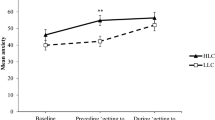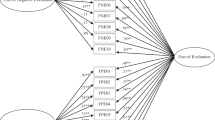Abstract
The disambiguation of threat/neutral homophones was investigated in high- and low-trait anxiety subjects who had been exposed to either a positive or a negative mood manipulation procedure. Subjects were required first to spell each auditorily presented word and second, to generate and speak a sentence using the word. Difference indices were calculated for the spelling and the sentence usage data, i.e. the number of threat minus neutral interpretations. Examination of these indices revealed that subjects exposed to the negative mood manipulation procedure produced relatively more threat than neutral interpretations (for both spelling and sentence usage) than did subjects exposed to the positive mood manipulation procedure. Multiple regression analyses revealed that both the trait anxiety and mood manipulation variables contributed significantly to the prediction of the difference index on the spelling task. In the analysis of the use of homophones in sentences, only the mood manipulation variable contributed significantly to the prediction of the difference index on the sentence usage task.
Similar content being viewed by others
References
Beck, A. T., Ward, C. H., Mendelson, M., Mock, J. E., & Erbaugh, J. K. (1961). An inventory for measuring depression.Archives of General Psychology, 4, 561–571.
Eysenck, M. W., MacLeod, C. & Mathews, A. (1987). Cognitive functioning and anxiety.Psychological Research, 49, 189–195.
French, C. C., Richards, A. & Smith, D. (1990).Word associations to threat/neutral homophones: Correlations with anxiety, sex and age. Submitted for publication.
Mathews, A. Richards, A. & Eysenck, M. W. (1989). Interpretation of homophones related to threat in anxiety states.Journal of Abnormal Psychology, 98, 145–153.
Richards, A., & French, C. C. (1990). Central versus peripheral presentation of stimuli in an emotional Stroop task.Anxiety Research, 3, 41–49.
Richards, A., & Millwood, B. (1989). Colour-identification of differentially valenced words in anxiety.Cognition and Emotion, 3, 171–176.
Richards, A. & Whittaker, T. M. (1990). Effects of anxiety and mood manipulation in autobiographical memory.British Journal of Clinical Psychology, 29, 145–153.
Richards, A., French, C. C., Johnson, W., Naparstek, J. & Williams, J. (1992).Effects of mood manipulation and anxiety on performance of an emotional Stroop task.British Journal of Psychology, 83, 479–491.
Spielberger, C. D., Gorsuch, R. L., Lushene, R., Vagg, P. R., & Jacobs, G. A. (1983).Manual for the State-Trait Anxiety Inventory (Form Y). Palo Alto, CA: Consulting Psychologists Press.
Author information
Authors and Affiliations
Rights and permissions
About this article
Cite this article
Richards, A., Reynolds, A. & French, C.C. Anxiety and the spelling and use in sentences of threat/neutral homophones. Current Psychology 12, 18–25 (1993). https://doi.org/10.1007/BF02737089
Accepted:
Issue Date:
DOI: https://doi.org/10.1007/BF02737089




